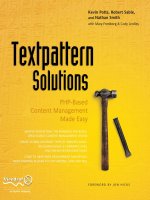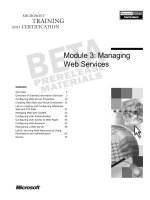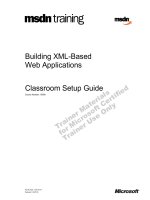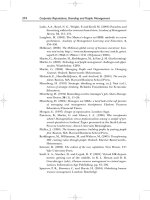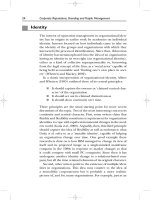Tài liệu Professional SharePoint® 2007 Web Content Management Development pdf
Bạn đang xem bản rút gọn của tài liệu. Xem và tải ngay bản đầy đủ của tài liệu tại đây (8.69 MB, 459 trang )
Wiley Publishing, Inc.
Professional
SharePoint
®
2007 Web Content
Management Development
Building Publishing Sites with Office SharePoint
Server 2007
Andrew Connell
ffirs.indd iiiffirs.indd iii 5/8/08 5:14:10 PM5/8/08 5:14:10 PM
ffirs.indd iiffirs.indd ii 5/8/08 5:14:09 PM5/8/08 5:14:09 PM
Professional
SharePoint
®
2007 Web Content
Management Development
Foreword ................................................................................................... xxiii
Introduction ............................................................................................... xxv
Chapter 1: Embarking on Web Content Management Projects ......................... 1
Chapter 2: Windows SharePoint Server 3.0 Development Primer ................... 19
Chapter 3: Overview of Web Content Management in Microsoft Office
SharePoint Server 2007 .............................................................. 39
Chapter 4: SharePoint Features and the Solution Framework ......................... 51
Chapter 5: Minimal Publishing Site Definition ............................................... 69
Chapter 6: Site Columns, Content Types, and Lists ....................................... 89
Chapter 7: Master Pages and Page Layouts ................................................ 109
Chapter 8: Navigation ................................................................................ 137
Chapter 9: Accessibility ............................................................................. 145
Chapter 10: Field Types and Field Controls ................................................. 157
Chapter 11: Web Parts .............................................................................. 179
Chapter 12: Leveraging Workflow ............................................................... 211
Chapter 13: Search ................................................................................... 241
Chapter 14: Authoring Experience Extensibility .......................................... 269
Chapter 15: Authentication and Authorization............................................. 291
Chapter 16: Implementing Sites with Multiple Languages and Devices ........ 305
Chapter 17: Content Deployment ............................................................... 321
Chapter 18: Offline Authoring with Document Converters ............................ 345
Chapter 19: Performance Tips, Tricks, and Traps ..........................................369
Chapter 20: Incorporating ASP.NET 2.0 Applications ....................................385
Index .........................................................................................................403
ffirs.indd iffirs.indd i 5/8/08 5:14:08 PM5/8/08 5:14:08 PM
ffirs.indd iiffirs.indd ii 5/8/08 5:14:09 PM5/8/08 5:14:09 PM
Wiley Publishing, Inc.
Professional
SharePoint
®
2007 Web Content
Management Development
Building Publishing Sites with Office SharePoint
Server 2007
Andrew Connell
ffirs.indd iiiffirs.indd iii 5/8/08 5:14:10 PM5/8/08 5:14:10 PM
Professional SharePoint® 2007 Web Content Management
Development: Building Publishing Sites with
Office SharePoint Server 2007
Published by
Wiley Publishing, Inc.
10475 Crosspoint Boulevard
Indianapolis, IN 46256
www.wiley.com
Copyright © 2008 by Wiley Publishing, Inc., Indianapolis, Indiana
Published simultaneously in Canada
ISBN: 978-0-470-22475-5
Manufactured in the United States of America
10 9 8 7 6 5 4 3 2 1
Library of Congress Cataloging-in-Publication Data:
Connell, Andrew, 1976-
Professional SharePoint 2007 Web content management development : building publishing sites with
Office SharePoint server 2007 / Andrew Connell.
p. cm.
Includes index.
ISBN 978-0-470-22475-5 (paper/website)
1. Web site development—Computer programs. 2. Web sites—Management.
3. Database management. 4. Microsoft Office SharePoint server. I. Title.
TK5105.8885.M54C66 2008 006.7'8—dc22
2008016811
No part of this publication may be reproduced, stored in a retrieval system or transmitted in any form or by any means,
electronic, mechanical, photocopying, recording, scanning or otherwise, except as permitted under Sections 107 or 108 of
the 1976 United States Copyright Act, without either the prior written permission of the Publisher, or authorization
through payment of the appropriate per-copy fee to the Copyright Clearance Center, 222 Rosewood Drive, Danvers,
MA 01923, (978) 750-8400, fax (978) 646-8600. Requests to the Publisher for permission should be addressed to the Legal
Department, Wiley Publishing, Inc., 10475 Crosspoint Blvd., Indianapolis, IN 46256, (317) 572-3447, fax (317) 572-4355, or
online at />Limit of Liability/Disclaimer of Warranty: The publisher and the author make no representations or warranties with
respect to the accuracy or completeness of the contents of this work and specifically disclaim all warranties, including
without limitation warranties of fitness for a particular purpose. No warranty may be created or extended by sales or
promotional materials. The advice and strategies contained herein may not be suitable for every situation. This work is
sold with the understanding that the publisher is not engaged in rendering legal, accounting, or other professional
services. If professional assistance is required, the services of a competent professional person should be sought. Neither
the publisher nor the author shall be liable for damages arising herefrom. The fact that an organization or Website is
referred to in this work as a citation and/or a potential source of further information does not mean that the author or the
publisher endorses the information the organization or Website may provide or recommendations it may make. Further,
readers should be aware that Internet Websites listed in this work may have changed or disappeared between when this
work was written and when it is read.
For general information on our other products and services please contact our Customer Care Department within the
United States at (800) 762-2974, outside the United States at (317) 572-3993 or fax (317) 572-4002.
Trademarks: Wiley, the Wiley logo, Wrox, the Wrox logo, Wrox Programmer to Programmer, and related trade dress are
trademarks or registered trademarks of John Wiley & Sons, Inc. and/or its affiliates, in the United States and other coun-
tries, and may not be used without written permission. Microsoft and SharePoint are registered trademarks of Microsoft
Corporation in the United States and/or other countries. All other trademarks are the property of their respective owners.
Wiley Publishing, Inc., is not associated with any product or vendor mentioned in this book.
Wiley also publishes its books in a variety of electronic formats. Some content that appears in print may not be available
in electronic books.
ffirs.indd ivffirs.indd iv 5/8/08 5:14:10 PM5/8/08 5:14:10 PM
To my lovely and inspiring wife, Meredith, and my son, Steven, who always manages
to put a smile on my face. I’m truly a lucky man.
—AC
ffirs.indd vffirs.indd v 5/8/08 5:14:10 PM5/8/08 5:14:10 PM
ffirs.indd viffirs.indd vi 5/8/08 5:14:10 PM5/8/08 5:14:10 PM
About the Author
Andrew Connell has a background in content management solutions and Web development that spans
back to his time as a student at the University of Florida in the late 1990s managing class sites. He has
consistently focused on the challenges facing businesses to maintain a current and dynamic online
presence without having to rely constantly on Web developers or have a proficiency in Web technologies.
In 2005 and 2006 he was designated a Microsoft Most Valuable Professional (MVP) for Microsoft Content
Management Server for his contributions to the MCMS community. When the functionality of MCMS
was merged into the SharePoint platform, he became a MOSS MVP (2007 and 2008). Andrew has
contributed to numerous MCMS and SharePoint books over the years.
He has spoken on the subject of MOSS 2007 development and WCM at various events and national
conferences such as TechEd, SharePoint Connections, VSLive, Office Developer Conference, and the
Microsoft SharePoint Conference.
Technology is not only Andrew’s job, but also a personal passion: He thrives on expanding his technical
knowledge. When not in front of his computer, he enjoys football, golf, the beach, and spending time
with his family. He lives in Jacksonville, Florida, with his wife, Meredith, his son, Steven, and their two
dogs. You can always find Andrew online at his SharePoint development and WCM-focused blog at
www.andrewconnell.com/blog
.
About the Technical Editors
The technical editing of this book was performed by quite a few industry experts, all of whom served
a pivotal role in ensuring that the content and code samples in this book are factually correct:
J. Dan Attis (
www.devcow.com/blogs/jdattis
), Microsoft MVP for Windows SharePoint
Services, has been heavily involved in the local developer community in the Atlanta, Georgia
area for nine years. He has been known to spend many nights and weekends working to
promote SharePoint in the community as a development platform. He is a stickler for details
and an ideal choice for editing the book.
Jason Conway (
/>) is a senior application developer
and team lead for Ascentium, with over a decade of experience delivering custom solutions in
a large range of markets and industries. He now applies that experience to designing and
developing solutions for corporate intranets and extranets using SharePoint 2007.
Stefan Gordon (
www.stefangordon.com
) is a software architect with Ascentium, an avid
blogger, and a dedicated SharePoint evangelist.
Cale Hoopes (
) is a mountaineer, application developer
with Ascentium, SharePoint enthusiast, musician, gamer, and beloved husband.
Jared Lasater is an application developer with Ascentium. He has been working with SharePoint
2007 since Beta 2 and has developed a wide range of enterprise solutions for clients, including
intranets, extranets, and collaboration and publishing portals.
❑
❑
❑
❑
❑
ffirs.indd viiffirs.indd vii 5/8/08 5:14:11 PM5/8/08 5:14:11 PM
George Olson is a developer in the portals and collaboration practice at Ascentium and is an
expert in designing and developing custom SharePoint workflows as part of large enterprise
solutions.
Michael Panciroli is a solutions architect with Ascentium who successfully delivered the first
Technology Adoption Program (TAP) project for Office SharePoint Server. He architects custom
enterprise solutions with SharePoint to deliver corporate intranets and partner extranets in the
health care, automotive, and online retail verticals.
Brendon Schwartz (
/>) is a principal consultant
in Atlanta, Georgia, specializing in SharePoint 2007. A Microsoft MVP for Microsoft Office
SharePoint Server, Brendon is also a co-author of Professional SharePoint 2007 Development (Wiley,
2007), author of several magazine articles, a conference speaker, and co-founder of the Atlanta
.NET Regular Guys, which is hosted at DevCow (
www.devcow.com
).
Clint Simon (
www.ascentium.com/blog/sp
) is a technology lead with Ascentium who draws
on his vast experience with SharePoint to create innovative development and platform tools for
SharePoint; his advancements extend and enhance SharePoint as a custom application
development platform.
Patrick Tisseghem (
www.u2u.info/Blogs/Patrick
) is a managing partner at U2U,
a SharePoint training company in Belgium. Patrick is also a Microsoft MVP for Windows
SharePoint Services and author of Inside Microsoft Office SharePoint Server 2007 (Microsoft
Press, 2007).
Roxana Tzau has many years of experience as a Web developer and helped build one of the
largest corporate intranet portals within Microsoft using SharePoint Server 2007 with
Ascentium. She continues to develop solutions for enterprise corporate intranets by extending
the SharePoint platform.
Thomas Wyrick is a Senior Software Engineer at the Ascentium Corporation and has had part in
delivering enterprise class solutions on the Microsoft platform.
❑
❑
❑
❑
❑
❑
❑
About the Technical Editors
viii
ffirs.indd viiiffirs.indd viii 5/8/08 5:14:11 PM5/8/08 5:14:11 PM
Acquisitions Editor
Katie Mohr
Development Editor
Kenyon Brown
Technical Editors
J. Dan Attis
Jason Conway
Stefan Gordon
Cale Hoopes
Jared Lasater
George Olson
Michael Panciroli
Brendon Schwartz
Clint Simon
Patrick Tisseghem
Roxana Tzau
Thomas Wyrick
Production Editor
William A. Barton
Copy Editor
Luann Rouff
Credits
Editorial Manager
Mary Beth Wakefield
Production Manager
Tim Tate
Vice President and Executive Group Publisher
Richard Swadley
Vice President and Executive Publisher
Joseph B. Wikert
Project Coordinator, Cover
Lynsey Stanford
Proofreader
Jennifer Larsen, Word One
Indexer
Robert Swanson
ffirs.indd ixffirs.indd ix 5/8/08 5:14:11 PM5/8/08 5:14:11 PM
ffirs.indd xffirs.indd x 5/8/08 5:14:11 PM5/8/08 5:14:11 PM
Acknowledgments
No project of this size can come be completed in a vacuum. I asked some of my trusted associates to
contribute to the book by writing a few of the chapters. First and foremost, I want to thank Spencer
Harbar (
www.harbar.net
), MVP for Office SharePoint Server, a good friend who I met in the days of
Microsoft Content Management Server 2002. Spencer was instrumental in developing the structure and
approach of this book, acting as a sounding board for various decision points in the process. He also
contributed Chapter 3, “Overview of Office SharePoint Server 2007 and Web Content Management,”
and Chapter 17, “Content Deployment.” Bob German (
/>)
contributed Chapter 1, “Embarking on Web Content Management Projects,” and Chapter 16,
“Implementing Sites with Multiple Languages and Devices.” Matt McDermott (
http://blogs
.catapultsystems.com/matthew
), MVP for Office SharePoint Server, contributed Chapter 13,
“Search,” and John Holliday (
www.johnholliday.net
), MVP for Office SharePoint Server, contributed
Chapter 5, “Minimal Publishing Site Definition.”
I also want to thank those at Microsoft who provided support, as well as those who assisted in
answering some of the technical questions: Arpan Shah, Ryan Duguid, Lawrence Liu, Jim Masson,
George Perantatos, and Tyler Butler.
No technical book is complete without a solid review to ensure that the code compiles and the text in the
chapters is factually correct. Many members of Ascentium were instrumental in reviewing the book.
Ascentium is an interactive marketing and technology consultancy that delivers solutions ranging from
interactive marketing, customer relationship management, business intelligence, portals, and
collaboration to application and product development and infrastructure management. A special thanks
to Jason Conway, who coordinated the review efforts of Stefan Gordon, Cale Hoops, Jared Lasater,
George Olson, Michael Panciroli, Clint Simon, Roxana Tzau, and Thomas Wyrick. I’d also like to thank
my fellow SharePoint MVPs Patrick Tisseghem and especially Dan Attis and Brendon Schwartz, who
reviewed a handful of chapters in a very short amount of time.
I would like to thank everyone at Wiley Publishing who helped me get this book to you. Like all projects
of this magnitude, the original plans were thrown out the window a few times when unexpected turns
presented themselves. Katie Mohr, Jim Minatel, and Kenyon Brown made this a fun and rewarding
experience.
In addition, I’d like to thank all of my former students who spent a week with me attending my Office
SharePoint Server 2007 Web Content Management class for developers (
www.andrewconnell.com/
go/299
), and those who left comments on my blog (
www.andrewconnell.com/blog
). All of you were
instrumental in helping with the development of the presentation of topics covered in this book and
I greatly appreciate the dialog we have shared.
Finally, I’d like to thank those in the MVP SharePoint community for the energetic, passionate,
challenging, and at times insane discussions that we share on a private distribution list. I cannot express
how privileged I feel to be among some of the best and brightest minds in the SharePoint field. Hats off
to April Spence, Melissa Travers, and Lawrence Liu at Microsoft for all they have done to help build,
facilitate, and bring this community together.
ffirs.indd xiffirs.indd xi 5/8/08 5:14:11 PM5/8/08 5:14:11 PM
ffirs.indd xiiffirs.indd xii 5/8/08 5:14:12 PM5/8/08 5:14:12 PM
Contents
Foreword xxiii
Introduction xxv
Chapter 1: Embarking on Web Content Management Projects 1
The Web Content Management Experience 2
Authors and Editors 2
Designers and Developers 4
Designing and Planning a Successful WCM Solution 7
Use Case Scenarios 7
Site Structure and Navigation 7
Page Layouts and Content Types 10
Supporting Content: Images, Attachments and Reusable Content 11
Site Definitions 12
Roles and Permissions 13
User Profiles and Targeting 14
Search Strategy 15
Summary 16
Chapter 2: Windows SharePoint Server 3.0 Development Primer 19
SharePoint Architecture 19
SharePoint on the File System and in Internet Information Services 21
SharePoint Site Topology 22
SharePoint Administration 24
Central Administration 24
Site Settings 24
List Settings 25
STSADM.EXE 26
WSS 3.0 and ASP.NET 2.0 Development 27
Like ASP.NET 2.0 27
Unlike ASP.NET 2.0 29
Types of Pages 31
Site Pages 31
Application Pages 32
ftoc.indd xiiiftoc.indd xiii 5/9/08 5:13:05 PM5/9/08 5:13:05 PM
Contents
xiv
Uncustomized Versus Customized Files 32
Customization versus Development 34
SharePoint Customization 34
SharePoint Development 35
Introducing the Microsoft.SharePoint Namespace 36
Debugging in WSS 3.0 37
Summary 38
Chapter 3: Overview of Web Content Management in Microsoft
Office SharePoint Server 2007 39
Web Content Management on the Microsoft Platform 39
Microsoft Office SharePoint Server 40
The ABCs of Web Content Management 42
Authoring 42
Branding 43
Controlled Publishing 43
Publishing Sites 44
Site Collections 46
Shared Services Providers 46
Microsoft.SharePoint.Publishing Namespace 47
Summary 49
Chapter 4: SharePoint Features and the Solution Framework 51
Overview of SharePoint Features 51
Anatomy of a Feature 52
Feature Scope 53
Element Manifests 54
Feature Receivers 55
Feature Administration 56
Feature Dependencies and Stapling Features 57
Creating Features Using Visual Studio 59
Overview of WSS Solution Packages 59
Anatomy of a WSS Solution Package 60
Solution Deployment 63
Creating WSS Solution Packages 63
Summary 67
ftoc.indd xivftoc.indd xiv 5/9/08 5:13:06 PM5/9/08 5:13:06 PM
Contents
xv
Chapter 5: Minimal Publishing Site Definition 69
Elements of a Publishing Site 70
The Pages Library 70
Styles and Images 70
Master Pages and Page Layouts 70
Content Types 71
Examining the Publishing Portal Site Definition 71
Publishing Feature PublishingWeb 72
Publishing Feature Publishing 72
Publishing Feature PublishingSite 73
Publishing Feature PublishingPrerequisites 73
Publishing Feature PublishingResources 73
Publishing Feature PublishingLayouts 73
Publishing Feature Navigation 74
Publishing Feature PublishingStapling 74
The Challenge with the Publishing Portal Site Definition 74
Creating a Publishing Site Definition 74
The Significance of Site Definitions 75
Custom Site Provisioning 76
The WEBTEMP File 79
The ONET.XML File 80
The Feature Manifest 87
The Feature Elements 88
Deploying and Testing the Custom Site Definition 88
Summary 88
Chapter 6: Site Columns, Content Types, and Lists 89
Site Columns 90
Site Column Names and IDs 90
Creating Site Columns 91
Content Types 94
Content Type IDs 95
Creating Content Types 96
Role of Site Columns and Content Types in Publishing Sites 99
Lists 100
Special Publishing Lists 100
Creating Lists 102
Accessing Lists via the SharePoint API 106
Summary 107
ftoc.indd xvftoc.indd xv 5/9/08 5:13:07 PM5/9/08 5:13:07 PM
Contents
xvi
Chapter 7: Master Pages and Page Layouts 109
Page Rendering Process Overview 109
Master Pages in Publishing Sites 110
Types of Master Pages 110
Master Page Tokens 113
Creating Master Pages 115
Incorporating Design Elements 123
Page Layouts 124
Creating Page Layouts 124
Adding Content Regions: Field Controls and Web Part Zones 130
Building Master Pages and Page Layouts As Templates 133
Delegate Controls 133
Creating Delegate Controls 134
Summary 136
Chapter 8: Navigation 137
ASP.NET 2.0 Navigation Provider Model 137
Customizing Site Navigation 138
Browser-Based Customizations 138
Customizing the Navigation Control 139
Customizing the Navigation Site Map Data Source 140
Customizing the Navigation Provider 140
Customizing Navigation with the API 141
Creating Custom Navigation Components 142
Performance and Usability Considerations 142
PortalSiteMapProvider 142
Table of Contents Web Part 144
Summary 144
Chapter 9: Accessibility 145
What Is an Accessible Web Site? 145
Measuring Accessibility 146
WCAG 1.0 147
WCAG 2.0 149
United States Rehabilitation Act of 1973 Section 508 150
W3C Markup Validation Service 151
Advantages to Creating Accessible Web Sites 151
Creating Accessible SharePoint Sites 152
Challenges to Creating Accessible SharePoint Sites 153
ftoc.indd xviftoc.indd xvi 5/9/08 5:13:07 PM5/9/08 5:13:07 PM
Contents
xvii
Accessibility Kit for SharePoint 154
Position and Goals of the AKS 155
Installation and Implementation 155
Summary 156
Chapter 10: Field Types and Field Controls 157
Overview of All the Moving Parts 158
Creating Custom Field Types and Controls 159
Creating a Custom Field Type 160
Creating a Custom Field Type Definition 160
Creating a Custom Field Value 162
Creating a Custom Field Control 164
Adding Design-Time Rendering Preview 170
Adding Custom Data Validation 172
Creating Custom Field Controls without Custom Field Types 173
Implementing Custom Field Controls in Page Layouts 177
Summary 178
Chapter 11: Web Parts 179
Adding Web Parts to Web Part Zones 180
Using Web Parts in Publishing Sites 180
Creating Custom Web Parts 181
Creating ASP.NET Web Parts, Not SharePoint Web Parts 182
Advanced Web Part Techniques 182
Creating a Weather News Web Part 184
Making ASP.NET Web Parts Work in SharePoint Sites 191
SharePoint Web Part Deployment Options 192
MOSS 2007 Publishing Web Parts 195
Summary Links Web Part (and Field Control) 196
Table of Contents Web Part 197
Content Query Web Part 197
Advanced Content Query Web Part Customization 199
Implementing a Customized CQWP Solution 204
Deploying Customized Content Query Web Part Customizations and Renderings 207
Summary 208
Chapter 12: Leveraging Workflow 211
Understanding Windows Workflow Foundation 211
Windows Workflow Foundation Terminology and Architecture 212
ftoc.indd xviiftoc.indd xvii 5/9/08 5:13:08 PM5/9/08 5:13:08 PM
Contents
xviii
Activities 214
Types of Workflows 214
Creating Custom Workflows 215
Developing Custom Workflows with Visual Studio 215
Overview of SharePoint’s Workflow Proposition 215
Architecture 216
Terminology 216
History and Task Lists 218
Interacting with Users with Forms 219
Workflow in SharePoint Publishing Sites 220
Overview of the Parallel Approvers Workflow 220
Creating Custom Workflows for SharePoint Publishing Sites 221
Creating Workflows with SharePoint Designer 221
Creating Workflows with Visual Studio 221
Summary 240
Chapter 13: Search 241
Planning for Search 242
Issues 242
Questions to Ask 242
Search Is a Business Problem 244
Search Center Design and Configuration 244
Search Center vs. Search Site 244
Results Page Anatomy 247
Search Results Configuration 248
Enhancing Search Results with Pivot 250
Adding Fields to the Results 252
Empty Results 256
Search Administration and Configuration 256
Central Administration 258
Site Collection Search Settings 258
Thesaurus File Configuration 259
Thesaurus Files 259
Noise Word Configuration 261
Advertising OpenSearch Capability 261
Telling the Browser Where to Search 262
Telling Applications Where to Search 264
Custom Enhancements for Search 265
BDC Integration with Search 265
Business Value from Structured Data 266
Microsoft Search Server 2008 Express 266
Summary 267
ftoc.indd xviiiftoc.indd xviii 5/9/08 5:13:08 PM5/9/08 5:13:08 PM
Contents
xix
Chapter 14: Authoring Experience Extensibility 269
Customizing SharePoint Navigation with Custom Actions 269
Offline Authoring with Document Converters 271
Edit Model Panel 272
Customizing the HTML Editor Field Control 273
Enabling and Disabling Buttons 273
Adding Custom Buttons 274
Customizing Available CSS Classes 278
Telerik RadEditor Lite for MOSS 279
Customizing the Page Editing Toolbar 280
Creating Page Editing Toolbar Actions 281
Adding Items to the PET Page Editing Menu 283
Adding Buttons to the PET Quick Access Buttons 284
Deploying Page Editing Toolbar Customizations 285
Summary 289
Chapter 15: Authentication and Authorization 291
SharePoint Security Components 291
Permission Rights 291
Permission Levels 292
SharePoint Groups 293
Securable Objects 293
Additional Publishing Security Components 293
SharePoint Security via the API 295
Alternate Access Mappings 296
Authentication Provider Model 296
Configuring Forms-Based Authentication 297
Anonymous Access 302
Summary 304
Chapter 16: Implementing Sites with Multiple Languages and Devices 305
Developing Multilingual Web Sites 305
Installing the Language Packs 307
Using Variations 308
Building Language-Agile Features 311
Targeting Devices with Variations 318
Creating Variations for Mobile Devices 318
Redirecting Mobile Users 318
Master Pages, Page Layouts, and Style Sheets 319
Summary 319
ftoc.indd xixftoc.indd xix 5/9/08 5:13:08 PM5/9/08 5:13:08 PM
Contents
xx
Chapter 17: Content Deployment 321
Content Deployment Fundamentals 322
Paths 323
Jobs 324
Quick Deploy Jobs 324
Configuring Content Deployment 325
Content Deployment Walkthrough 327
Example Scenario 327
Creating Paths 328
Creating Jobs 330
Running Jobs 334
Leveraging Quick Deploy Jobs 337
Using the Content Deployment API 337
Using the Content Migration API 339
Incremental Deployment 342
Summary 344
Chapter 18: Offline Authoring with Document Converters 345
Document Converter User Experience 346
Overview of the Document Converter Architecture 347
Updating Copy Files Post-Conversion and File Linkages 348
Conversion Priorities 349
Using Document Converters to Create Publishing Pages 349
Document Converter Configuration 350
Configuring Document Converter Services 350
Configuring Document Converter Content Types 352
Out-of-the-Box Document Converters 352
Word Document and Word Document with Macros to Web Page 352
InfoPath Form to Web Page 353
XML to Web Page 353
Creating Custom Document Converters 353
Creating the Document Converter 354
Creating the Document Converter Application 354
Deploying Custom Document Converters 359
Adding Settings to Document Converters 360
Working with Document Converters via the Object Model 366
Summary 367
ftoc.indd xxftoc.indd xx 5/9/08 5:13:08 PM5/9/08 5:13:08 PM
Contents
xxi
Chapter 19: Performance Tips, Tricks, and Traps 369
SharePoint Caching Options 370
Page Output Caching 370
Object Caching 371
Disk-Based Caching (BLOB Cache) 372
Limiting the Page Payload 372
SharePoint’s CORE.JS 374
Browser Cache and Content Expiration 378
Performance Programming Techniques 378
.NET Framework Disposable Objects 379
Working with SharePoint Disposable Objects 380
Working with Collections 381
Querying/Aggregating Data via the API 382
Summary 383
Chapter 20: Incorporating ASP.NET 2.0 Applications 385
Each Component Adds More Value 386
What ASP.NET 2.0 Brings to the Table 386
What WSS 3.0 Brings to the Table 387
What MOSS 2007 Brings to the Table 388
Advantages to Using SharePoint As an Application Development Platform 389
Incorporating Applications into SharePoint Sites 390
Implementing One or More Web Parts 390
Provisioning Site Pages 391
Application Pages 392
Data Storage Options 392
SharePoint Lists 392
External Database 394
Application Configuration Options 394
Utilizing SharePoint Components in Custom Applications 396
SharePoint Navigation 396
Leveraging SPGridView 397
Creating and Managing Custom Security Roles 399
Summary 401
Index 403
ftoc.indd xxiftoc.indd xxi 5/9/08 5:13:09 PM5/9/08 5:13:09 PM
ftoc.indd xxiiftoc.indd xxii 5/9/08 5:13:09 PM5/9/08 5:13:09 PM

